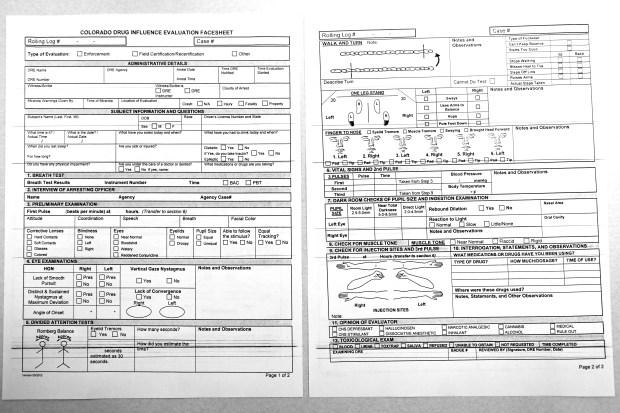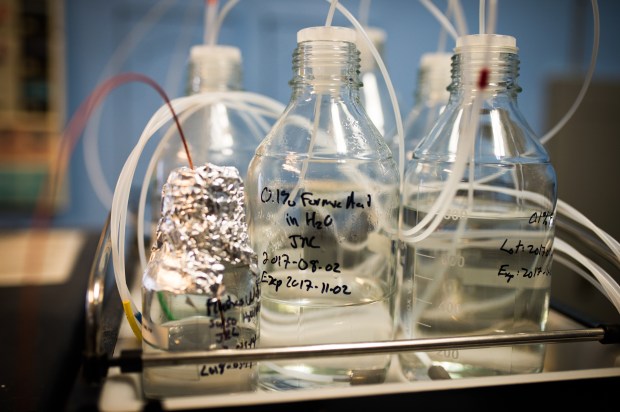There was a time when marijuana was illegal everywhere and testing for it was as easy as could be.
It didn’t matter the level of cannabinoids found in a person’s body. If it was there, they were breaking the law.
It’s different now.
The tests have changed from depositing a urine sample into a cup to drawing blood or offering oral fluids. Also different is the particular type of cannabinoid — the chemical compound that reacts in the brain — detected by any of those tests.
The evolving science of testing for marijuana, and the lack of consensus over how to measure impairment, is a defining feature of the drug. It separates marijuana from alcohol and creates challenges for lawmakers, police and prosecutors, not to mention users.
The issue is critical as the state moves forward in determining how to handle driving under the influence of pot. A Denver Post investigation found that the numbers of drivers in fatal crashes testing positive for marijuana — though not necessarily high — is rising sharply, and coroners are finding higher levels of potency in their tests.
The cannabinoid most widely tested for in the past – known as carboxy THC – is actually an inactive metabolite that only indicates prior marijuana use, sometimes as long as a month ago. In time, other metabolites of THC — short for tetrahydrocannabinal, the psychoactive ingredient in marijuana — were found to be better indicators of recent use and, some say, impairment.
“Urine testing was established many years ago, and, at the time, a test was developed to look for carboxy THC since it’s what’s there in the highest amount,” said Sarah Urfer, president and owner of ChemaTox, a Boulder lab that handles DUI screening for about three quarters of the law enforcement agencies in Colorado. “Nobody thought it mattered what you were looking for. … Early on, scientists didn’t know for sure which of the cannabinoids were responsible for impairment. They’d measure carboxy and try to correlate it to impairment.”
But THC is not the same as alcohol. It reacts differently in the body, it metabolizes differently and its impairing impact is different. Unlike the 0.08 blood-alcohol level that’s widely accepted as indicative of drunken driving, establishing a credible level for THC has been elusive.
It is generally accepted that two standard drinks — about 1/2 ounce of alcohol — in an hour will raise someone’s blood-alcohol level to 0.05, approaching the legal limit. One drink is a 12-ounce beer, a 1.5-ounce shot of distilled spirit, or a 6-ounce glass of wine.
For pot, the differences are striking since it depends on the manner ingested — smoked, edible, concentrate — and how much. A Johns Hopkins University study from 1995 found that four puffs of smokable marijuana with 1.75 percent THC content translates to 57 nanograms per milliliter, and 10 puffs as much as 99 ng/mL. The National Highway Traffic Safety Administration says levels of 100-200 ng/mL are “routinely encountered” after smoking but quickly dissipate.
Concentrate levels for vapor ingestion are typically higher, as well as for edibles, although the rate of distribution into the blood varies considerably.
Feds question tests
NHTSA last month acknowledged these gray areas in a report to Congress that not only called into question the reliability of tests to find THC but also noted the problem with determining whether a driver is too stoned to be behind the wheel.
In fact, the NHTSA report notes that even though “research has demonstrated the potential of marijuana to impair driving-related skills,” it lays out a number of other studies that show pot might not be as bad as the better-understood effects of alcohol on driving.
“Many studies, using a variety of methods, have attempted to estimate the risk of driving after use of marijuana,” the NHTSA report noted. “While useful in identifying how marijuana affects the performance of driving tasks, experimental and observational studies do not lend themselves to predicting real-world crash risk.”
Finding THC isn’t so difficult. Making any kind of universally accepted determination from the results, however, seems to freeze the legal world in its tracks.
“Testing for THC in whole blood isn’t actually that hard,” Urfer said. “Where the issue comes is with interpretation and roadside testing.”

Some widely cited studies have offered differing information about the impact of marijuana on driving. And not all sides agree which studies are right and which are not.
In 2012, a medical study published in Clinical Chemistry journal found “cannabis smoking increases lane weaving and impaired cognitive functions,” and that certain THC concentration levels “are associated with substantial driving impairment, particularly in occasional smokers.”
Then came a University of Colorado study — released in 2014, the year recreational sales of the drug were launched in the state – that found the proportion of drivers involved in fatal crashes who tested positive for marijuana use had risen to 10 percent in 2011, up from 5.9 percent in 2009.
But in 2015, NHTSA released a study it conducted in Virginia that concluded marijuana users had the same chance of crashing as sober drivers. At nearly the same time, the Washington Traffic Safety Commission said it believed marijuana doubles the risk of being in a fatal crash.
Where experts say impairment becomes most noted and is most alarming to law enforcement because of its prevalence is the use of alcohol with marijuana, apparently heightening the effects of each.
In Colorado last year, nearly 36 percent of all drivers involved in fatal crashes who tested positive for marijuana use also had consumed alcohol, according to the Colorado Department of Transportation.
“We’re in the infancy with this, and it’s very much an unknown since we don’t have the data,” Greenwood Village Police Chief John Jackson said. “We spent 25 or 30 years figuring out where we were are with alcohol, and finally got to breathalyzers. There is no field test for marijuana yet. You will not convince those who believe it’s safer that it’s not. It becomes so emotional to the point of irrational.”
Differing approaches

Colorado has established that a THC level of 5 ng/mL is enough to charge someone with DUI. Unlike alcohol, where a reading of 0.08 is enough to convict someone of drunken driving — known as per se evidence that a driver is impaired — THC levels are only considered as “permissible inference” of impairment.
That means that despite the level of Delta-9 THC found in a driver’s blood, a Colorado jury or judge decides whether the driver was impaired or not.
Washington and Montana, unlike Colorado, treat the same 5 ng/mL level of THC as if it were alcohol, where no other proof of impairment is needed to convict a driver charged with DUI. However, 12 states — including Arizona and Utah — have zero-tolerance policies, so any detectable amount of THC can lead to a conviction.
In its recent report to Congress, NHTSA questioned the THC levels states use to charge someone with impaired driving, calling them “artificial.”
“A number of states have set a THC limit … indicating that if a suspect’s THC concentration is above that level, … then the suspect is to be considered impaired,” the agency said in its report. “This per se limit appears to have been based on something other than scientific evidence.”
Urfer agreed.
“Permissible inference is a government-derived number that was part of the discussion around legalization,” said Urfer, who spoke before the committees that prepared for Amendment 64, the voter initiative that legalized recreational marijuana use in Colorado. “I’ve always said 5 (ng/mL) was a bad number.”
That’s because of how THC works its way through a person’s system, Urfer said, noting that if a single number had to be used, then using none at all makes the best sense “since it’s already illegal to drive when under the influence of a drug.”
“Impairment drops off over the next two to four hours,” she said of marijuana use. “The levels of THC drop off astronomically fast. But that drop-off in blood is distributing into the brain and the muscles of the body. And impairment comes from the brain.”
That means blood levels of THC are probably far lower at the time a test is done than at the time of a crash or other traffic infraction. Yet, the THC is still in the driver’s system — just not in their blood. That’s led lawyers and others to contend that someone isn’t actually impaired if their THC level is below 5 ng/mL.
“The public is misinterpreting the statement that you can’t tell if someone’s high because of the THC level,” Urfer said. “You can’t directly correlate a number to impairment. The blood level for THC does not represent the same as alcohol does.”
THC levels hit their peak nearly instantaneously at the time someone uses marijuana and dissipate very quickly. What’s detected in the blood is typically much lower than it had been at the time of use, especially when a sample is taken long after a crash occurs.
“The level in the blood is dropping, but the level in the brain is not,” Urfer said. “The high is caused by the level in the brain, not in the blood. And no one has published a study that says it’s safe to drive high.”
As expected, there has been strong push-back from the marijuana industry, which says the only thing understood about THC levels is that very little is understood.
“There needs to be better understanding about what constitutes impairment,” said Kristi Kelly, executive director of the Marijuana Industry Group, a Colorado trade organization. “The science on cannabis metabolism doesn’t support the legal 5 ng/mL limit in Colorado, which can be present for days and weeks after consumption.”
Roadside testing could be improving, with the advent of a saliva test that could bring more immediate and reliable information about the level of active THC in a person’s system. The Colorado State Patrol has been using it in preliminary tests to determine its reliability.
“The inference is that at or above 5 (ng/mL), you’re high, but there should be no inference that below 5 you’re sober,” Urfer said. “But people genuinely believe they can use an impairing substance, feel high and still think they can be safe to drive. They rationalize: ‘Marijuana is legal. Why can’t I drive on it?’ They say it all the time. It’s odd.”
